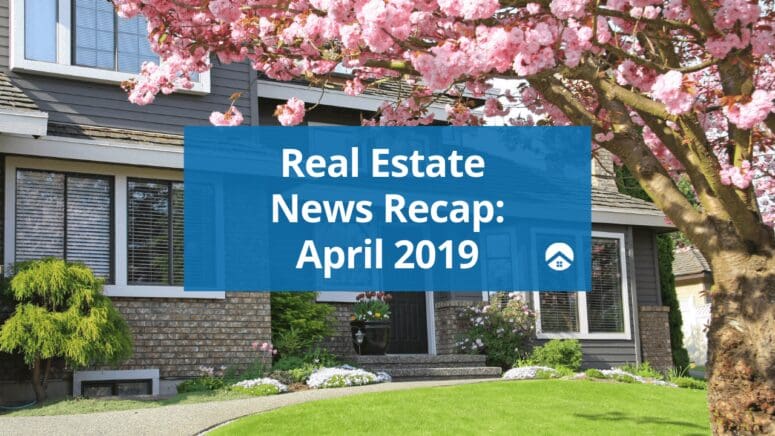No Jokes, Only the Top Stories in Housing: HomeLight’s April 2019 Real Estate News Recap
- Published on
- 6-7 minutes
-
 Catrina Sun-Tan Contributing AuthorClose
Catrina Sun-Tan Contributing AuthorClose Catrina Sun-Tan Contributing Author
Catrina Sun-Tan Contributing AuthorCatrina is a native San Franciscan with a B.A. in Psychology and minor in Cinema and Media Studies from Wellesley College. A storyteller at heart, she loves to write about people, films, and of course, real estate. Don't be surprised if you catch her browsing luxury homes on Instagram or obsessing over the latest market trends.
As the weather gets warmer and you bust out the compost bags for some yard cleanup, it’s time for another round of HomeLight’s Real Estate News Recap. We’re surviving the allergies, keeping dry during the April showers, and of course, scouring the internet for the latest housing-related news.
In April, mortgage applications hit a 9-year high as buyers take advantage of lower-than-expected interest rates, home prices and the pace of home sales beat analysts’ initial predictions, and Midwest homeowners faced ‘Biblical’ level flooding. We also found out which city ranks as the best place to live in the U.S. and saw some creative solutions to the affordable housing crisis emerge.
That’s quite the mix…Let’s buckle down and get right into the top stories you missed in April:

1. Survey says…
In the first quarter of 2019, HomeLight surveyed over 900 top agents across the U.S. for their best spring home-selling tips, staging secrets, home renovation recommendations, and predictions for where they think the real estate market is headed this year.
+ HomeLight, Seller’s Market Prevails But Homeowners Should Take Care to Set the Right Price, According to HomeLight’s New Top Agent Insights Survey for Q1 2019:
“In the first quarter of 2019, 58 percent of top real estate professionals across the U.S. characterized their local housing market as a ‘seller’s market,’ however 55 percent projected local inventory to rise, making it particularly important for homeowners to set the right asking price, according to findings from HomeLight’s Top Agent InsightsTM survey for Q1 2019.
“The Top Agent Insights survey spans a wide range of subject matter, with 30 multiple choice and open-ended questions about the housing market and best tips and practices for selling homes. HomeLight plans to release a version of the Top Agent Insights survey on a quarterly basis to share insights into seasonal and recurring trends in the market.”
For more key findings, download a full copy of the survey report below.
2. Everyone still wants a mortgage
As we reported in March, the Federal Reserve indicated that it does not plan to raise interest rates again in 2019, a sign that the economy is slowing down. Homebuyers, however, are taking advantage of the suppressed rates in droves.
+ Realtor, Updated Realtor.com® Forecast Paints Rosier Picture for 2019 Homebuyers:
Here’s what Danielle Hale, chief economist of realtor.com, reported: “The 2019 housing market is different than what we predicted in fall 2018, primarily due to an unexpected drop in mortgage rates in January 2019. We believe 2019 will be characterized by lower, but still increasing mortgage rates that will buoy home prices and sales by boosting buyers’ purchasing power beyond what we initially projected. This will create a slightly hotter, but still cooling housing market relative to the initial forecast five months ago.”

+ Market Watch, Mortgage Rates Tick Up, but Applications Still Hit a 9-year High:
In April, mortgage rates increased ever so slightly: 30-year fixed mortgages went up to 4.17% from 4.12% at the beginning of the month. These numbers are still historically low, and “Consumers seem to know that,” Market Watch reported. “Applications for purchase mortgages hit a nine-year high in the most recent week, even as rates ticked slightly higher, the Mortgage Bankers Association said Wednesday. Demand is strong, and many Americans who’ve been shut out of a hyper-competitive housing market for years may finally get their chance.”
+ HomeLight’s take: With the current low mortgage rates, buyer demand is still high and the real estate market is much stronger than analysts originally forecasted. But, even so, you’ll still need to price your house competitively and be prepared for negotiations.

3. Happy Earth Day… sort of
April showers bring May flowers. Or, if you’re in the Midwest, record level snow brings the worst spring flooding in history and billions of dollars in damage to farmland and housing.
+ Yale Climate Connections, Did Climate Change Cause the Flooding in the Midwest and Plains?:
“The answer is a perfect storm of factors. The fingerprints of mid-March flooding in the area can be traced back to the summer of 2018 and the wet months that followed. Some of the root causes—like wetter weather and rapid spring warm ups—have become more likely due to climate change.”
+ NYTimes, Why Is There Flooding in Nebraska, South Dakota, Iowa and Wisconsin?:
“The devastating effect came mainly from what the rain fell upon: a snow-covered region that was unable to absorb much of the blow.
“‘A lot of it stems from the fall flooding in September and October,’ said Mindy Beerends, a senior meteorologist at the Des Moines office of the National Weather Service. ‘The soil was saturated in the fall. The higher-than-average precipitation, combined with warm temperatures, snowmelt and the frozen ground, was a perfect storm for flooding,’ Ms. Beerends added. ‘The ingredients were in place.’”
Another contributing factor? Outdated levees along the Mississippi. Across 500 miles of levee built, there were more than 50 breaches in the past month.

+ Vice News, The Midwest Needs More than Levees to Survive its “Biblical” Floods:
“In 1936 Congress assigned the task of flood protection on to the Army Corps of Engineers. It built levees, dikes and dams along thousands of miles of the Missouri and Mississippi rivers. The levees stopped flooding but made the rivers straighter, deeper, and more powerful—which contributed to a 20% increase in the risk of a 100-year flood. So building higher barriers as climate change brings heavier rainfall could make future flooding worse.”
What about the housing market? So far, the floods have destroyed acres of land and delayed the construction of hundreds of home.
+ HousingWire, Housing Starts Fall to Slowest Pace Since 2017 Led by Flood-Ravaged Midwest:
“Today’s construction report showed three of four U.S. regions posted declines in housing starts led by a 17.6% drop in the Midwest, where rain and melting snow caused widespread flooding in March. Housing starts in the South fell 7.2%, in the Northeast they fell 4.4%, and in the West they rose 31.4%, according to the report.”
HomeLight’s Take:
Remember, standard homeowners insurance doesn’t cover flood damage. So, if you’re in a high-risk area, it’s worth double-checking what your house is covered for and whether you should explore options that do cover your home in an event such as this.
+ USA Today, The Waters Are Rising, the Floods Are Coming. What Are we Doing to Save Ourselves?
Another avenue that homeowners in flood zones have explored is building homes that are “hazard-resistant.”
“’It’s actually cheaper to build hazard-resistant homes than it is to build to the minimum building codes and then fix things,’ said Jeremy Gregory, a research scientist at the department of civil and environmental engineering at the Massachusetts Institute of Technology who studied Katrina and other disasters.
“Individual homeowners can raise foundations, so their homes are farther above ground and less likely to flood. In areas of Florida and the East Coast, homes are built on piers to hold them even higher.”
4. HUD Happenings
The U.S. Department of Housing and Urban Development has been lighting up the press in April with new rules and new propositions.
+ Realtor.com, HUD Seeks Input on Maximizing ‘Opportunity Zones’
The Department of Housing and Urban Development is seeking public comment on how it can use “Opportunity Zones” to better benefit residents and communities. The federal Opportunity Zone Program, created by the Tax Cuts and Jobs Act of 2017, seeks to aid economic development in distressed areas by offering real estate investors significant tax breaks. More than 8,700 communities have been designated ripe for revitalization and fall within “Opportunity Zones.”

HomeLight’s Take: We covered Trump’s executive order on creating a council for opportunity zones in December, 2018. There hasn’t been much news after that (or success and completion) on opportunity zones, and we’ll probably have to wait another couple of years before we see more development in these areas.
+ In other news, HUD Moves to Limit Public Housing Aid for Undocumented Immigrants (NY Times).
“The Trump administration proposed a rule on Wednesday night intended to prevent undocumented immigrants from receiving federal housing assistance, the latest step in its efforts to ramp up enforcement of the nation’s immigration laws.
“The rule was delivered to Congress on Wednesday night for a 15-day review period. After that, there will be 60 days for public comment. If the rule goes into effect, undocumented immigrants living in public housing would not be immediately removed, the official said. They would be given up to 18 months, through three six-month waivers, to relocate.”
5. Basic human need
Affordable housing is needed now more than ever, and in response to the crisis, some cities are taking it into their own hands to find solutions.
+ CityLab, How Single-Family Garages Can Ease California’s Housing Crisis:
“Many single-family neighborhoods have garages that can provide a new supply of small, well-located, and high-quality apartments within walking distance of stores and public transit. Converted garages can house boomerang children, grandparents, caretakers, guests, or friends. Or they can generate rental income to make home ownership more affordable.”

+ KTVB, Shipping containers become the latest solution to the Treasure Valley’s affordable housing crisis:
One developer, Windy Court in Idaho, is creating affordable homes for rent out of shipping containers.
“Each home is 960 square feet, features four bathrooms, two bathrooms and is available to rent for $843 a month—including utilities.”
Bart Cochran, president of LEAP Charities, is “thinking outside the container and helping build affordable housing one shipping container at a time.”
+ WSOC TV, Council Expected to Approve $12M Plan to Fight Affordable Housing Crisis:
“Charlotte City Council members plan to greenlight a more than $12 million plan for the city’s ongoing affordable housing crisis… Leaders have said the plan is all about helping some of the Queen City’s most vulnerable people find an affordable place to live. Recent Department of Housing and Urban Development data indicates the need for more than 21,000 affordable housing units for families at or below 50 percent of the median area income.”

6. Keep Austin Weird, and the best place to live in the US
Results are in for U.S. News and World Report’s 125 Best Places to Live in America and Austin, Texas, came out on top, with the highest scores in value, desirability, job market strength, and quality of life.
+Market Watch, The No. 1 Best Place to Live in America Is …
“Forbes ranked it the best city for jobs and it has an unemployment rate of just 2.6%. It’s also one of the fastest-growing cities in the nation as people move for jobs, weather and a better quality of life. And Austin is awash with things to do, including a thriving music scene, plenty of outdoor recreation and world-class museums and cultural happenings.”
+HomeLight’s Take:
If you’re thinking of buying a house in Austin, we’ve got you covered. We help home buyers connect with the top real estate agents in their area who are proven to negotiate better deals for their clients and who know the area like the back of their hand. Connect with a top buyer’s agent in Austin, TX to get your search started.
7. Shifting values
According to a new study by LendingTree, millennials prioritize homeownership before marriage, among other things. Makes sense when these 22-37 year olds make up 37% of homebuyers today.
A majority of millennials are also putting parenthood in the backburner in exchange for a mortgage, which is a complete 180 from their baby boomer parents and older age groups.

+ Lending Tree, Nearly 1 in 4 Millennial Homebuyers Want to Buy a Home Before They’re Married
“Young adults are getting married later than previous generations. In 1980, the median age for men and women at their first marriage was 24.7 and 22, respectively. In 2018, the ages increased to 29.8 and 27.8, for men and women, respectively.
But this delay in marriage isn’t deterring them from homeownership. Almost a quarter of millennials say they are postponing marriage until after they buy a home, according to LendingTree’s latest survey.”
+ HomeLight’s take: And, what are millennials replacing relationships and children with?
Pets and plants. So, if you’re staging a house, add a couple of palm plants and fix up the fence around the yard for pet parents who want to keep their doggos safe.
Like what you’ve read?
Get this every month. Plus, home selling tips from America's top agents.

